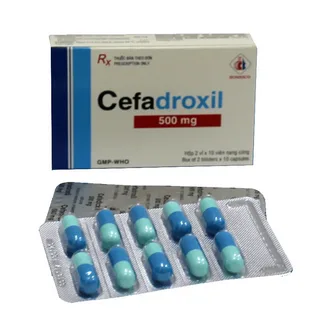Cefadroxil - Product Description
Overview:
Cefadroxil is a first-generation cephalosporin antibiotic used to treat a variety of bacterial infections, including those affecting the skin, throat, and urinary tract. It works by disrupting the formation of the bacterial cell wall, causing the bacteria to die. Cefadroxil is effective against both Gram-positive and some Gram-negative bacteria, making it a versatile treatment option. It is available in capsule and liquid suspension forms, allowing for flexibility in administration. The drug’s once or twice-daily dosing regimen makes it convenient for patients, improving adherence to the prescribed course. Side effects are generally mild, with gastrointestinal discomfort being the most common. Cefadroxil’s broad-spectrum activity, combined with its proven safety, makes it a trusted choice for treating a wide range of bacterial infections.
Indications:
Cefadroxil is indicated for the treatment of various bacterial infections, particularly those caused by susceptible strains of bacteria. Common indications include skin and soft tissue infections, such as cellulitis and impetigo, pharyngitis and tonsillitis (especially strep throat), and urinary tract infections. Cefadroxil is also used to treat bone and joint infections, as well as respiratory tract infections like bronchitis. Its broad-spectrum activity allows it to effectively treat infections caused by both Gram-positive and certain Gram-negative bacteria. Cefadroxil’s versatility in treating different types of bacterial infections makes it a valuable antibiotic in clinical practice, particularly for patients who require a reliable and well-tolerated treatment option.
How to Use:
Cefadroxil is typically taken orally in the form of a capsule or liquid suspension. The dosing is usually once or twice daily, depending on the severity of the infection and the patient’s age and weight. It is important to take Cefadroxil at the same time each day to maintain consistent levels of the medication in the bloodstream. The drug can be taken with or without food, but taking it with food may reduce the risk of stomach upset. Patients should follow their healthcare provider’s instructions carefully and complete the full course of therapy, even if they start feeling better, to ensure that the infection is fully eradicated. Missing doses or stopping the medication early can lead to the return of the infection and increase the risk of antibiotic resistance.
Advantages:
Cefadroxil offers several advantages as an antibiotic, including its broad-spectrum activity, which allows it to treat a variety of bacterial infections effectively. Its convenient once or twice-daily dosing improves patient adherence, ensuring that the full course of therapy is completed. Cefadroxil’s well-established safety profile makes it a trusted choice for treating infections in various populations, including children and the elderly. Additionally, its flexibility in formulation (capsules and liquid suspension) allows for easy administration. These advantages make Cefadroxil a reliable and effective option for managing bacterial infections.
Conclusion:
Cefadroxil is a first-generation cephalosporin antibiotic that effectively treats a range of bacterial infections, including skin, throat, and urinary tract infections. Its broad-spectrum activity, combined with convenient dosing and a proven safety profile, makes it a preferred choice for healthcare providers and patients alike. Completing the prescribed course of Cefadroxil is essential to ensure successful treatment and prevent the development of antibiotic resistance. With its long history of safe and effective use, Cefadroxil remains an important tool in the fight against bacterial infections.
Composition:
Cefadroxil contains the active ingredient cefadroxil monohydrate, a first-generation cephalosporin antibiotic. It works by inhibiting the synthesis of the bacterial cell wall, leading to cell death. Inactive ingredients in the capsule formulation may include cellulose, magnesium stearate, and sodium starch glycolate, while the liquid suspension may contain flavoring agents, sweeteners, and preservatives. The combination of these ingredients ensures that Cefadroxil is effective in treating bacterial infections while being well-tolerated by patients. The drug’s formulation allows for consistent dosing and bioavailability, making it a reliable choice for treating a variety of bacterial infections.
Note:
Patients taking Cefadroxil should be aware of potential side effects, such as mild gastrointestinal discomfort, including nausea, diarrhea, or stomach pain. While these side effects are generally mild, more serious reactions, such as allergic reactions (rash, itching, swelling), should be reported to a healthcare provider immediately. Patients with a history of allergy to cephalosporins or penicillins should inform their healthcare provider before starting Cefadroxil. The medication should be taken exactly as prescribed, and the full course of therapy should be completed, even if symptoms improve early. This helps prevent the return of the infection and the development of antibiotic-resistant bacteria. Pregnant or breastfeeding women should consult their healthcare provider before taking Cefadroxil. Additionally, it is important to inform the healthcare provider of any other medications being taken, as Cefadroxil can interact with certain drugs.






